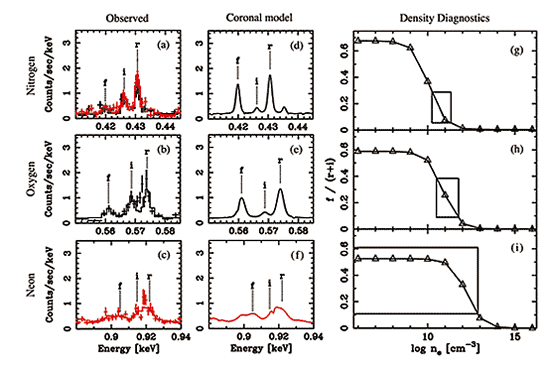TOP > Report & Column > The Forefront of Space Science > 2007 > Physics of Cataclysmic Variable Investigated by X-ray Spectroscopic
![]()

Magnetic cataclysmic variable AE Aquarii If white dwarfs have a magnetic field of 10tesla or more, matter from the companion star escapes from the accretion disk in its accreting process and moves along the magnetic lines to accrete intensively on the dwarfs’ magnetic poles. Since X-rays are radiated from the magnetic pole areas that appear and disappear due to white-dwarf rotation, the X-ray intensity varies in sync with the rotation cycle. These cataclysmic variables are called the “magnetic cataclysmic variables.” For magnetic cataclysmic variable AE Aquarii, its rotation period of 33.08 seconds was identified by visible-light observation. This value is the fastest among magnetic cataclysmic variables and the rotation speed on its equator indeed reaches 35% of the Kepler velocity there. Since the X-ray intensity varied at the period, for a long time AE Aqr was thought to be a magnetic cataclysmic variable where ordinary mass accretion took place. Since it shows the following specific behaviors not seen with other cataclysmic variables, however, it was considered special.

Research into the cause of the uniqueness of AE Aqr has advanced largely with our X-ray spectroscopic analysis of data from the XMM-Newton satellite. XMM-Newton carries a reflection-type, diffraction-grating spectrometer with better energy-resolution capability than CCD. As shown in Fig. 4, it can spectroscope the characteristic X-rays from nitrogen, oxygen, and helium-like ion of neon into three components. We can identify the plasma density based on the relative intensity of the two components. From this intensity information and the absolute brightness of the three components, we discovered that the plasma extends to the orbits of the binary system. This suggests that the X-rays from AE Aqr do not come from its magnetic poles but are emitted from around its magnetosphere. Because of the white dwarf’s high rotation speed, matter from the companion star cannot accrete on the white dwarf and is blown outside the binary system. So, what causes the X-ray intensity changes coincident with its rotation period? Since its discovery, the rotation period of AE Aqr has slowed down at a rate of 1.8 microseconds per year. It is supposed that AE Aqr is a white dwarf version of radio pulsar that shines using de-acceleration energy. In fact, the hard X-ray detector onboard SUZAKU began to catch signs of non-thermal-pulse component, first discovered with cataclysmic variables. The detection of non-thermal X-ray pulses from AE Aqr has very important implications. White dwarfs having magnetic field and rotating at a period of around 10 seconds have the capability of particle acceleration up to around 1014-15eV. White dwarfs are common stars in the galactic system and, although not yet widely known, one in three stars near the solar system is white dwarf. If non-thermal pulses are detected in fast-rotating white dwarfs other than AE Aqr, white dwarfs should be highlighted as acceleration sources of high-energy cosmic rays. (Manabu ISHIDA)
|
||||||||||||||||




